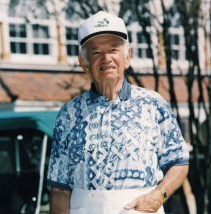
Villages founder Harold Schwartz was known for many things, but one that stood out above all others was his love for the retirement community he helped bring to life in Central Florida.
Schwartz, who died at the age of 93 right before Christmas in 2003, was a man old-time Villagers knew as a friend and neighbor. He lived among them in what is now known as the Historic Section of The Villages. And he enjoyed talking with them and finding out what they thought would make the community a better place to call home.
Schwartz acquired the original Orange Blossom Gardens – a small trailer park in the middle of nowhere in Central Florida – in 1983 after a disagreement with his partner about the future of the community. He brought his son, H. Gary Morse, in to manage OBG and its 386 mobile homes. And together, the duo started making improvements, like adding swimming pools and golf courses, that would propel the successful formation of The Villages.

Schwartz wanted many things for his residents, but at the top of his list was a hospital located in the community. So in 1997, as Morse was embroiled in a political battle to secure that coveted medical facility, the 87-year-old Schwartz took the bold step of putting his image on a billboard, pointing at the ground, with the words, “I’ll live to see The Villages Regional Hospital right here!”
Of course, those who knew Schwartz weren’t at all surprised by the flashy billboard. As a young man, he played the violin and regularly wore tailored suits with pleated shirts and a fedora. And he drove a fancy Packard Phaeton while working as a traveling salesman for his father’s tailoring company before it became a victim of The Great Depression.
At one point, Schwartz owned a mail-order business. And in 1947 he started buying radio stations, believing strongly in the fact that owning the airwaves and using his marketing skills to sell mail-order merchandise could lead to big money.

Among the radio stations Schwartz owned were two in Mexico known as “border busters.” Those high-powered operations sat just across the border and were able to broadcast to a good part of the United States. And in those days, they were a primary source of entertainment for families.
During his radio days, Schwartz made one of the biggest finds of his life. He hired a young disc jockey from Brooklyn named Bob Smith and put him in his Tijuana station serving the Los Angeles area. And with some help from Schwartz, Smith transformed into Wolfman Jack, one of the most famous disc jockeys in the history of radio and a man who always will be remembered for his role in the 1973 hit movie “American Graffiti.”

But Schwartz’s biggest achievement was working alongside Morse to turn Orange Blossom Gardens into The Villages and make it a fully contained retirement community. He certainly had a knack for making the place known – when Hacienda Hills Golf and Country Club opened, Schwartz flew professional golfer Chi Chi Rodriguez in for the grand opening. It was an experience he labeled as the most exciting in his career.
By 1989, The Villages was off to the races. Orange Blossom Gardens had become one of 16 villages in the community. And it became time to construct the first town square, to be called Spanish Springs.
Schwartz finally retired in 1994 and enjoyed his final years relaxing in the community he helped bring to life. He turned over operation of the community to Morse and his children – Mark Morse, Tracy Mathews and Jennifer Parr – and enjoyed time with the many good friends he’d made in The Villages.

Today, Schwartz is remembered by a statue that stands in one of the fountains at Spanish Springs Town Square. It was put there because that town square meant so much to him. And it serves as a reminder of the many accomplishments he achieved in his lifetime.
After Schwartz’s death, a ceremony was held in Spanish Springs Town Square. His ashes were locked in the base of the statue in a solemn moment for those who knew and loved Schwartz. And it was a quiet event that was watched from afar by the highly personal Morse, who viewed the proceedings from his office overlooking the statue above what is now Margarita Republic restaurant.

